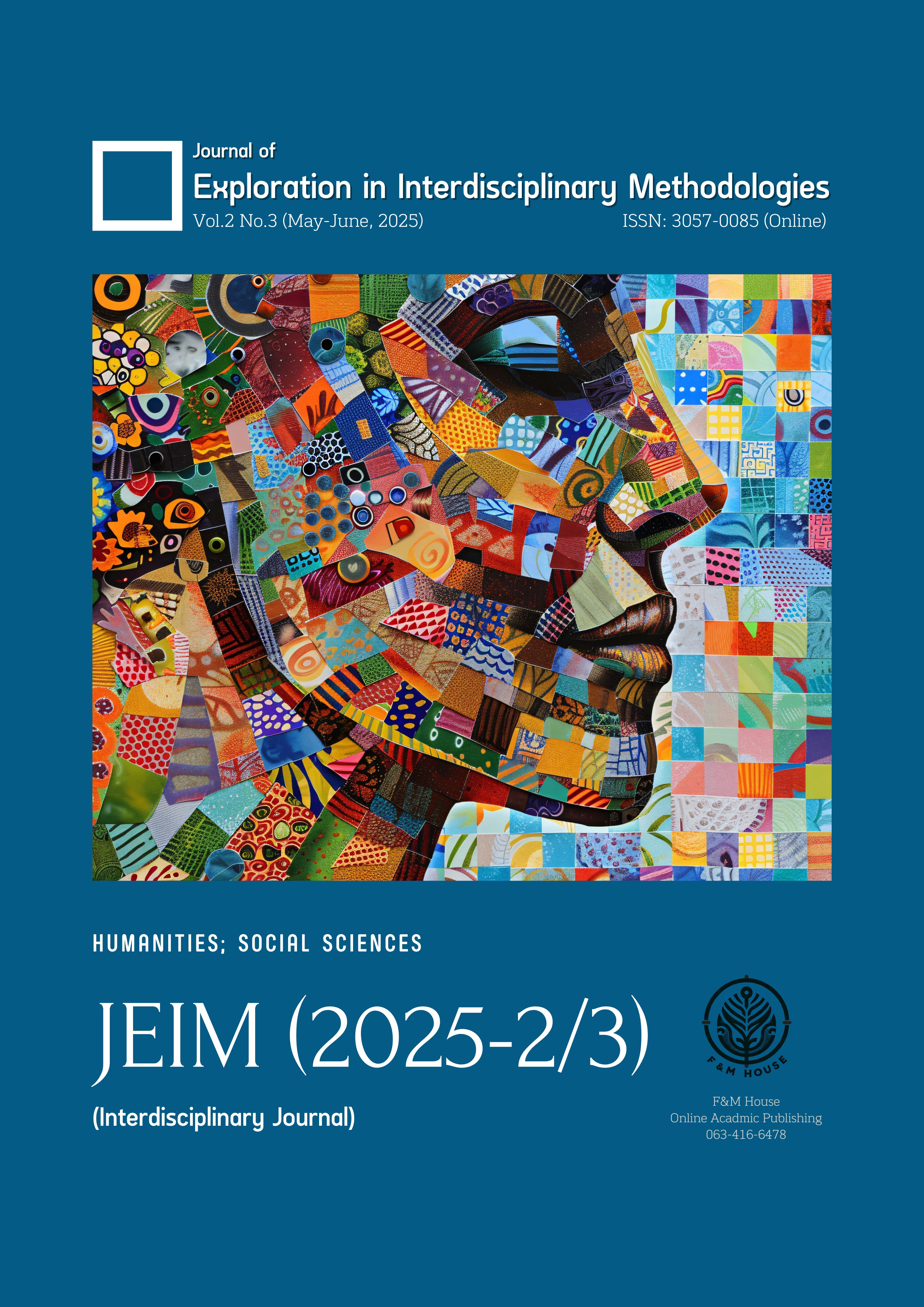Interdisciplinary Approaches to Cultural Conservation: A Model for Sustainable Social Development
คำสำคัญ:
Cultural Conservation, Sustainable Development, Interdisciplinary Approaches, Community-Based Conservation, Digital Documentationบทคัดย่อ
This paper explores interdisciplinary approaches to cultural conservation as a foundation for sustainable social development. In the face of globalization, urbanization, and environmental challenges, cultural heritage preservation requires the integration of diverse academic perspectives, including anthropology, environmental science, economics, and technology. By examining community-based conservation models, sustainable resource management, and digital documentation techniques, this study highlights the necessity of cross-disciplinary collaboration to enhance cultural resilience and identity. The research underscores the significance of stakeholder engagement, policy integration, and innovative technologies such as virtual reality and Geographic Information Systems (GIS) in preserving tangible and intangible heritage. Furthermore, the paper discusses how economic valuation and sustainable tourism practices can generate financial support for cultural conservation while maintaining ecological balance. By adopting a holistic framework that bridges scientific and local knowledge, this study advocates for inclusive and adaptive conservation strategies that align with sustainable development goals. The findings contribute to a broader understanding of how cultural heritage can be safeguarded while fostering social, economic, and environmental sustainability.
เอกสารอ้างอิง
Adams, B., Berkes, F., de Athayde, S. F., Dudley, N., et al. (2009). The intersections of biological diversity and cultural diversity: Towards integration. Retrieved from https://core.ac.uk/download/9064509.pdf
Adger, N., Ashford, G., Badyaev, A., Bahn, M., Baird, J., Barton, M., et al. (2016). The human–nature relationship and its impact on health: A critical review. Retrieved from https://core.ac.uk/download/163076696.pdf
Arts, B., Buizer, M., Horlings, L., Ingram, V., van Oosten, C., & Opdam, P. F. M. (2017). Landscape approaches: A state-of-the-art review. Annual Review of Environment and Resources, 42, 439-463. Retrieved from https://doi.org/10.1146/annurev-environ-102016-060932
Awasthi, P. K. (2024). Celebration of nature and culture through Gaura Parba: An interdisciplinary study of environmental stewardship and cultural sustainability. NPRC Journal of Multidisciplinary Research. Retrieved from https://www.semanticscholar.org/paper/b0fbaae78dcc0a2b4481dbeb09338f74d0a9f372
Awuah, K., Jha, K., et al. (2020). Urban heritage conservation and rapid urbanization: Insights from Surat, India. Retrieved from https://core.ac.uk/download/288395030.pdf
Balmer, I., Defila, R., DiGiulio, A., Kaufmann-Hayoz, R. (2011). Sustainable consumption: Towards action and impact. Retrieved from https://core.ac.uk/download/17203350.pdf
Baltazar, S. O. de A. G., Mifsud, J., Pretorius, R., Walter, L., et al. (2017). Universities as living labs for sustainable development: A global perspective. Retrieved from https://core.ac.uk/download/323186381.pdf
Bennett, N., Roth, R., Klain, S. C., Chan, K. M. A., Christie, P., Clark, D. A., Cullman, G., et al. (2016). Conservation social science: Understanding and integrating human dimensions to improve conservation. Biological Conservation, 205, 93-108. Retrieved from https://doi.org/10.1016/j.biocon.2016.10.006
Bennett, N., Roth, R., Klain, S. C., Chan, K. M. A., Clark, D. A., Cullman, G., Epstein, G., et al. (2016). Mainstreaming the social sciences in conservation. Conservation Biology, 31(1), 56-66. Retrieved from https://doi.org/10.1111/cobi.12788
Beyer, R. (2018). A place for plants: Ethnobotany, bioregionalism, and folkways in Appalachia. Retrieved from https://core.ac.uk/download/345085801.pdf
Biber-Freudenberger, L., Denich, M., & Whitney, C. W. (2018). More inter- and transdisciplinary research needed in agroecology. Retrieved from https://core.ac.uk/download/161988907.pdf
Bieluch, K. H., Dreyer, S., Johnson, M. L., Levesque, et al. (2015). Sustainability science graduate students as boundary spanners. Retrieved from https://core.ac.uk/download/215540587.pdf
Boone, J. W., Carson, A., Hecklau, S. F., & Hughes, et al. (2011). Gettysburg College Sustainability Proposal. Retrieved from https://cupola.gettysburg.edu/cgi/viewcontent.cgi?article=1022&context=student_scholarship
Bortnyk, S., Lavruk, T., & Peresadko, V. (2024). Strategic spatial planning of territorial communities to achieve the Sustainable Development Goals. Visnyk of V.N. Karazin Kharkiv National University, series Geology, Geography, Ecology. Retrieved from https://www.semanticscholar.org/paper/70d1b17f1040fa82a431b39628ed2cd8167c949c
Brimblecombe, P., Cassar, M., Nixon, T., Price, et al. (2001). Technological requirements for solutions in the conservation and protection of historic monuments and archaeological remains. Retrieved from https://core.ac.uk/download/1682064.pdf
Campbell, J., Gillespie, A., Scrimgeour, F., Urich, et al. (2005). Human dimensions of global environmental change: A review of frameworks and research gaps. Retrieved from https://core.ac.uk/download/29194946.pdf
Canuel, E. (2016). Sustainable development, natural resource extraction, and the Arctic: The road ahead. Retrieved from https://core.ac.uk/download/62571069.pdf
Carabias, V., Castri, R., De Luca, V., Lobsiger-Kägi, et al. (2014). Favouring behavioural change of household’s energy consumption through social media and cooperative play. Retrieved from https://core.ac.uk/download/159414069.pdf
Chawla, L. (2020). Childhood nature connection and constructive hope: A review of research on connecting with nature and coping with environmental loss. People and Nature, 2, 619-642. Retrieved from https://doi.org/10.1002/pan3.10128
Danarta, A., Pradana, M. Y. A., Abror, I., Yahya, N. E. P. S. (2024). Encouraging religion and sustainable tourism as a conception of Indonesian halal tourism development. Revista de Gestão Social e Ambiental. Retrieved from https://www.semanticscholar.org/paper/3172ce6ab5a4b63b51181f256dfb8994111cd2a3
Dastgerdi, S. (2023). Developing a framework for improving climate resilience in cultural landscapes. Retrieved from https://core.ac.uk/download/614102394.pdf
Davy, B., Brown, D., Ovares, L., Haughton, M., & Breton, Y. (2006). Coastal resource management in the wider Caribbean: Resilience, adaptation, and community diversity. Retrieved from https://core.ac.uk/download/75777479.pdf
Dı́az, S., Pascual, U., Stenseke, M., Martín‐López, B., Watson, R. T., Molnár, Z., Hill, R., et al. (2018). Assessing nature's contributions to people. Science, 359(6373), 270-272. Retrieved from https://doi.org/10.1126/science.aap8826
Dwivedi, Y. K., Hughes, L., Kar, A. K., Baabdullah, A. M., Grover, P., Abbas, R., Andreini, D., et al. (2021). Climate change and COP26: Are digital technologies and information management part of the problem or the solution? International Journal of Information Management, 63, 102456. Retrieved from https://doi.org/10.1016/j.ijinfomgt.2021.102456
Dwyer, L. (2017). Saluting while the ship sinks: The necessity for tourism paradigm change. Journal of Sustainable Tourism, 26, 29-48. Retrieved from https://doi.org/10.1080/09669582.2017.1308372
Elyasi̇, S., & Yamacli, R. (2023). Architectural sustainability with cultural heritage values. Cultural Heritage and Science. Retrieved from https://www.semanticscholar.org/paper/2f011ff5432f4f809b543d8e21d236ca52841bd3
Gessert, G. (2015). This changes everything: Capitalism vs. the climate. Leonardo, 48, 496-497. Retrieved from https://doi.org/10.1162/leon_r_01130
Guerry, A. D., Polasky, S., Lubchenco, J., Chaplin-Kramer, R., Daily, G. C., Griffin, R., et al. (2015). Natural capital and ecosystem services informing decisions: From promise to practice. Proceedings of the National Academy of Sciences, 112, 7348-7355. Retrieved from https://doi.org/10.1073/pnas.1503751112
Hayles, N. K. (2018). Chaos bound. Cornell University Press eBooks. Retrieved from https://doi.org/10.7591/9781501722950
Helly, J. (1998). National Center for Ecological Analysis and Synthesis: The state of computational ecology. Retrieved from https://www.semanticscholar.org/paper/ccedee2996156473b8a6f12e7b1ce3cad07f7e64
Helly, J., Davis, F., Levin, S., & Michener, W. (1999). The state of computational ecology. Retrieved from https://www.semanticscholar.org/paper/b7483188ed47ff57ed41ee7fab0628110d40d5fe
Hidayati, P. I. (2021). Traditional production landscapes for sustainable development: Mainstreaming agricultural biodiversity in East Java, Indonesia. Retrieved from https://core.ac.uk/download/482753412.pdf
Hoang, H., Thu, T., Nguyen, T. Q. (2023). Stakeholder involvement and the attainment of SDGs at local tourism destinations: A case study in Vietnam. Retrieved from https://core.ac.uk/download/580134148.pdf
Howard, T. M., & Lawson, A. (2014). Soil governance: Accessing cross-disciplinary perspectives. Retrieved from https://core.ac.uk/download/213630367.pdf
Huang, H., & Singh, A. M. (2024). Creating sustainable artistic homestay: Approaches to design Weizhou Island into an ideal tourist attraction homestay. International Journal of Emerging Issues of Social Science, Arts, and Humanities. Retrieved from https://www.semanticscholar.org/paper/3c11bf4b0f097c9c8682d19f3a5eee214b4e0069
Intergovernmental Panel on Climate Change. (2023). Climate change 2022 – Impacts, adaptation and vulnerability. Retrieved from https://doi.org/10.1017/9781009325844
Kahiluoto, H. (2006). Conceptual framework. Retrieved from https://core.ac.uk/download/10924457.pdf
Kei, L. H., Bakri, N. A. A. B., Lin, P. Q., Khairunizan, H. K. B., Qing Yuan, K. H., & Abdullah, N. B. M. (2024). Mitigating human-elephant conflict: A comprehensive review of strategies for sustainable coexistence in support of SDG 15. Journal of Lifestyle and SDGs Review. Retrieved from https://www.semanticscholar.org/paper/7c882bd78248b2bedb8ae45fdeb5b55d789dd112
Li, J., Onlamul, K., Yang, F., & You, et al. (2024). Transmission guidelines for literacy studies in Si Zhu Yue traditional Chinese folk music. Retrieved from https://core.ac.uk/download/617871422.pdf
Li, Y., Lu, W., Wang, T., & Wu, et al. (2024). Surveying attitudinal alignment between large language models vs. humans towards 17 sustainable development goals. Retrieved from http://arxiv.org/abs/2404.13885
Liu, Z. (2003). Sustainable tourism development: A critique. Retrieved from https://core.ac.uk/download/9017025.pdf
Lyver, P. O. B., Timoti, P., Davis, T. J., & Tylianakis, J. M. (2019). Biocultural hysteresis inhibits adaptation to environmental change. Trends in Ecology & Evolution, 34(8), 771-780. Retrieved from https://doi.org/10.1016/j.tree.2019.04.002
McKinnon, M., Cheng, S., Dupre, S., Edmond, J., Garside, R., Glew, L., et al. (2016). What are the effects of nature conservation on human well-being? A systematic map of empirical evidence from developing countries. Environmental Evidence, 5. Retrieved from https://doi.org/10.1186/s13750-016-0058-7
Mondéjar, M. E., Avtar, R., Díaz, H. L. B., Dubey, R. K., Esteban, J., Gómez-Morales, A., Hallam, B., et al. (2021). Digitalization to achieve sustainable development goals: Steps towards a smart green planet. The Science of The Total Environment, 794, 148539-148539. Retrieved from https://doi.org/10.1016/j.scitotenv.2021.148539
Munsi, R. V. (2024). Harmony unveiled: Exploring the dynamic intersection of anthropology and sustainable development. Retrieved from https://core.ac.uk/download/617715423.pdf
Munsif, L., Gull, S., Musharraf, Q., Bibi, A., Fatima, R., & Rahman, A. U. (2024). Integrating social development and clinical psychology: Implications for enhancing mental health interventions. Scandic Journal Of Advanced Research And Reviews. Retrieved from https://www.semanticscholar.org/paper/884858abc4f536d3ebc7b79627e92dc459977bef
Nekhai, V., & Kulbako, A. (2023). Project approach in the preservation of the cultural heritage of Ukraine. Galic'kij ekonomičnij visnik. Retrieved from https://www.semanticscholar.org/paper/533d51aa8b3bc0ac164f6a7e2e2529629e3dd54a
Nesshöver, C., Assmuth, T., Irvine, K. N., Rusch, G. M., Waylen, K. A., Delbaere, B., et al. (2016). The science, policy, and practice of nature-based solutions: An interdisciplinary perspective. The Science of The Total Environment, 579, 1215-1227. Retrieved from https://doi.org/10.1016/j.scitotenv.2016.11.106
Nguyen, A. (2024). Cultural connections, conservation, and Chicagoland: The road to Calumet voices at the Field Museum of Natural History, 1984–2023. Retrieved from https://core.ac.uk/download/613179661.pdf
O’Neill, J., & Uebel, T. (2015). Handbook of ecological economics. Edward Elgar Publishing. Retrieved from https://doi.org/10.4337/9781783471416
Ortiz, A., Asiabanpour, B., Aslan, S., Jimenez, J., Kim, Y., & Salamy, H. A. (2015). Engaging students in sustainability education and awareness of green engineering design and careers through a pre-engineering program. Retrieved from https://www.semanticscholar.org/paper/8a7811a7cdd9a8c00b5dd77348c2066413fa897f
Østergård, H. (2008). Discussion documents – SUSVAR Visions Workshop, Karrebæksminde, Denmark, April 2008. Retrieved from https://core.ac.uk/download/10928157.pdf
Paavola, J., Rauschmayer, F., & Wittmer, H. (2025). Multi-level governance of natural resources: Tools and processes for water and biodiversity governance in Europe – A European research and training network. Retrieved from https://core.ac.uk/download/pdf/6558081.pdf
Pesaro, G., & Pedrazzini, L. (2025). The enhancement of knowledge, preservation and valorisation of historical settlements in the alpine area: An interdisciplinary approach. Retrieved from https://core.ac.uk/download/pdf/7046185.pdf
Rylance, A., Spenceley, A., Notarianni, M., Thompson, A., Paxton, M., Barborak, J. R., & Massyn, P. J. (2018). Tourism and visitor management in protected areas: Guidelines for sustainability. Retrieved from https://doi.org/10.2305/iucn.ch.2018.pag.27.en
Sajise, P. E. (2025). Biodiversity research for sustainable development: Can it be achieved? Retrieved from https://core.ac.uk/download/pdf/6486834.pdf
Sele, J. P., & Mukundi, M. B. (2024). Community-based approaches to environmental conservation: Empowering local initiatives. Greener Journal of Social Sciences. Retrieved from https://www.semanticscholar.org/paper/3aa80149a61e21792e5711996a589158c0b88976
Thaqi, N. V., & Thaqi, A. (2024). Assessing the influence of sustainable tourism practices on conservation and socio-economic development in Kosovo's protected areas. Academic Journal of Interdisciplinary Studies. Retrieved from https://www.semanticscholar.org/paper/1dbe99e4ddf4bb7f989f96a6ced2ba80a1bb3709
Whitmee, S., Haines, A., Beyrer, C., Boltz, F., Capon, A., de Souza Dias, B. F., Ezeh, A., et al. (2015). Safeguarding human health in the Anthropocene epoch: Report of The Rockefeller Foundation–Lancet Commission on planetary health. The Lancet, 386(10007), 1973-2028. Retrieved from https://doi.org/10.1016/s0140-6736(15)60901-1







